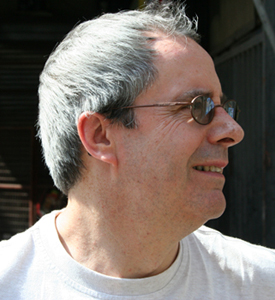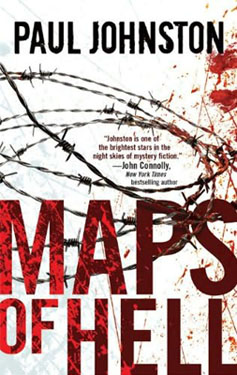 Ostensibly I’m here to talk about The Nameless Dead, the fourth and last in my series featuring crime writer turned investigator Matt Wells. So, before the knife cuts to the bone, as the Greeks say, let me do that.
Ostensibly I’m here to talk about The Nameless Dead, the fourth and last in my series featuring crime writer turned investigator Matt Wells. So, before the knife cuts to the bone, as the Greeks say, let me do that.
At the beginning of The Nameless Dead, Wells and his heavily pregnant lover Karen are being held prisoner in a joint FBI/US Army camp in Illinois, following their involvement in an attempt to assassinate the President (see book 3, Maps of Hell). They had been brainwashed and are undergoing treatment to reverse the process. Meanwhile, a series of violent murders leads the FBI to suspect that the mastermind behind the attack on POTUS is still at large. Wells is trained up and sent to find the criminal who messed with his mind, soon finding himself up against hired killers, a neo-Nazi conspiracy linked to a Satanic cult, and a fundamentalist Christian private military contractor. Oh, and his former lover Sara Robbins – now the deadly hit woman known as the Soul Collector (the title of book 2 in the series) – is back on his trail. To make things even worse (you know what thrillers do – multiply the hero’s jeopardy ad infinitum), Matt suffers the most appalling personal loss, one that drives him to a real underworld, set design courtesy of John Milton and Hieronymus Bosch. You can never have too much eschatology.
And now for coming clean. I wrote the first Matt Wells novel, The Death List, in a rage of enormous dimensions. I was so fired up that, after a week’s preparation, I hammered out a first draft in a month. I’d had a near lethal cancer, been dropped by my publishers and been fired by my agent (in this business, never show weakness, physical or mental). Despite receiving seventeen rejections in the UK, it ended up becoming an international bestseller. How did that happen? Well, apart from being picked up the good folks at Mira Books, the novel obviously benefited from my state of mind during the writing process.
But there was more going on, largely beneath the surface. To be frank, I was playing games, both with the reader and with the people who had chucked me into the garbage bin of publishing history. Matt Wells tells his parts of the stories in the first person. He’s a crime novelist. That makes him a seriously unreliable narrator, but it also meant that I could have all sorts of fun with the genre and with the publishing world. Wells becomes a private eye – surely every crime writer’s secret ambition – and I got to subject publishers, agents and critics to all kinds of lurid fates (anyone seen the great Vincent Price movie Theatre of Blood?), largely inspired by the Jacobean tragedian John Webster’s superbly gory The White Devil.
 In The Soul Collector, I turned my artillery on my fellow crime writers, several of whom are murdered in appalling ways. None are based of recognizable writers, of course – I actually like my partners in crime. Well, most of them. I also crammed in as many elements of the genre as I could – Christie-style puzzle clues, Dennis Wheatley-style Satanism, and ‘realistic’ gangsters. The literary underpinning was provided by Christopher Marlowe’s Doctor Faustus – all the characters, including Matt Wells, have made deals with the devil and it’s time to pay up. It has to be said that there’s a heavy dose of satire in the mix, but I don’t know how many readers got that. Fortunately, not many crime writers seem to have got it either, as I can still show my face at conventions.
In The Soul Collector, I turned my artillery on my fellow crime writers, several of whom are murdered in appalling ways. None are based of recognizable writers, of course – I actually like my partners in crime. Well, most of them. I also crammed in as many elements of the genre as I could – Christie-style puzzle clues, Dennis Wheatley-style Satanism, and ‘realistic’ gangsters. The literary underpinning was provided by Christopher Marlowe’s Doctor Faustus – all the characters, including Matt Wells, have made deals with the devil and it’s time to pay up. It has to be said that there’s a heavy dose of satire in the mix, but I don’t know how many readers got that. Fortunately, not many crime writers seem to have got it either, as I can still show my face at conventions.
Never one to shirk a challenge, I decided that the third Wells novel, Maps of Hell, would change everything. Matt wakes up with no memory of who he is and no knowledge of his whereabouts. And, at the same time, he is being framed for a series of grotesque murders in Washington DC. The epigraph is from Goethe’s Faust and the novel is an act of homage to Richard Condon’s amazingly daring The Manchurian Candidate (ignore the movie versions), as well as a satire on the substantially more leaden Robert Ludlum’s (and collaborators’) Jason Bourne books. What was I doing? Trying to combine an action-packed thriller with a subversion of the genre’s mores. Did readers go along with it? Search me; read the book and tell me via my web-site.
So what’s the exact nature of this coming clean (exclusive to Elizabeth A. White’s superb site)? What I’m saying is this: crime and thriller readers are consistently underestimated by (most) publishers and (many) writers. I believe they’re up for much more than just a rollicking story and tough guy/ gal protagonists. I think they want more than the usual conservative genre clichés and are willing to have their beliefs tested. That’s what I’ve tried to do in all my books, but none more so than those involving Matt Wells. I mean, no one wants to be nasty to an old lady, but it’s about time Murder, She Wrote was updated…and had a bucket of blood thrown over it. Happy, if challenging, reading.





Lucious Lamour
October 26, 2011 - 11:06 AM